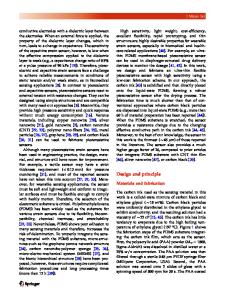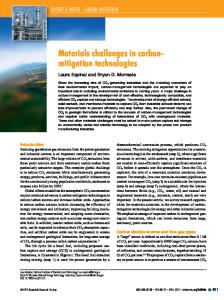Noise Mitigation Techniques for Carbon Nanotube-Based Piezoresistive Sensor Systems
- PDF / 1,046,950 Bytes
- 6 Pages / 432 x 648 pts Page_size
- 37 Downloads / 312 Views
Noise Mitigation Techniques for Carbon Nanotube-Based Piezoresistive Sensor Systems Michael A. Cullinan and Martin L. Culpepper Department of Mechanical Engineering, Massachusetts Institute of Technology, 77 Massachusetts Avenue, Cambridge, MA 02139, U.S.A.
ABSTRACT Carbon nanotube (CNT)-based piezoresistive strain sensors have the potential to outperform traditional silicon-based piezoresistors in MEMS devices due to their high strain sensitivity. However, the resolution of CNT-based piezoresistive sensors is currently limited by excessive 1/f or flicker noise. In this paper we will demonstrate several noise mitigation techniques that can be used to decrease noise in the CNT-based sensor system without reducing the sensor’s strain sensitivity. First, the CNTs were placed in a parallel resistor network to increase the total number of charge carriers in the sensor system. By carefully selecting the types of CNTs used in the sensor system and by correctly designing the system it is possible to reduce the noise in the sensor system without reducing sensitivity. The CNTs were also coated with aluminum oxide to help protect the CNTs from environmental variations. Finally, the CNTs were annealed to improve contact resistance and to remove adsorbates from the CNT sidewall. Overall, using these noise mitigation techniques it is possible to reduce the total noise in the sensor system by almost two orders of magnitude and increase the dynamic range of the sensors by 29 dB. INTRODUCTION Carbon nanotube-based piezoresistive strain sensors have the potential to outperform many traditional MEMS force and displacement sensors due to their high strain sensitivity [1]. However, CNT-based sensors typically suffer from large amounts of flicker noise which limits the resolution of these sensors [2]. Flicker noise is believed to be caused by the capture and release of charge carriers in localized trap states in the CNT [3]. The flicker noise in a CNT is given by Equation (1), where Į is the Hooge constant, Vs is the source voltage, f is the frequency, and N is the number of charge carriers in the resistor.
σ1/ f =
αVS2 N
§f · ln ¨ max ¸ © f min ¹
(1)
Overall, the Hooge constant for CNT-based sensors has been measured to be similar to other semiconducting materials such as polysilicon [4]. However, as sensor systems are scaled down to the nanoscale, the number of charge carriers is reduced and flicker noise increases. Therefore, due to the small number of charge carriers in the CNT-based devices, the noise in these devices tends to be dominated by flicker noise. In general, the amount of noise in the CNT sensor scales with the resistance of the sensor [2]. However, the total amount of noise in the in the CNT-based sensor system is highly
157
dependent on a number of sources related to the design of the sensor system and the conditions under which the sensor is manufactured and tested. For example, the amount of flicker noise in the sensor is higher when the sensor is exposed to the environment compared to when it is tested in a
Data Loading...











